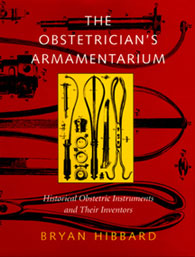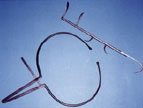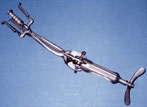Publications Medical & Scientific Instruments (also found under Obstetrics and Gynecology)
The Obstetrician’s Armamentarium:
Historical Obstetric Instruments and Their Inventors
Brian Hibbard, MD (London), PhD (Liverpool),
FRCOG, FRACOG (Hon)
$245.00
With over 500 illustrations, The Obstetrician’s Armamentarium traces the evolution of obstetric instruments from ancient times to the end of the nineteenth century in Britain, Europe, and America. Though there have been other histories of obstetrics and obstetric instruments, these have concentrated mainly on forceps and their development and have not been extensively illustrated. The Obstetrician’s Armamentarium is a survey of all types of obstetric instruments and contains definitive assessments of the different instruments and the procedures for which they are used, including forceps, extractors, fillets, tractors, levers, and pelvimeters, and analyzes their usefulness or lack thereof. There are also detailed discussions of the variety in blade length, handles, and articulations for numerous instruments. No other work available matches the scope of instruments discussed and the accompanying analyses. In addition, biographical sketches are given of the most influential figures in the field of obstetrics, including the Chamberlen Family, William Smellie, André Levret, James Young Simpson, David Davis, and Étienne Tarnier. This work will appeal to anyone interested in the history of obstetrics and obstetric instruments and will also be useful to instrument collectors for identification purposes. It is a truly monumental contribution to the history of obstetrics.
324 pages. 502 illustrations. Cloth, dust jacket, acid-free paper. 8 1/2" × 11". ISBN 0–930405-80–3. NP37973. December 2000.
» Skip to: About the Author | Reviews
About the Author
Bryan Montague Hibbard, MD, PhD, FRCOG, FRANZCOG (Hon), is Emeritus Professor of Obstetrics and Gynaecology in the University of Wales College of Medicine and was formerly Professor and Head of the Department of Obstetrics and Gynaecology and Consultant Obstetrician and Gynaecologist to the South Glamorgan Health Authority. Dr. Hibbard has, since 1973, served in many capacities at the Royal College of Obstetricians and Gynaecologists, including 8 years on the College Council, and is currently Curator of the Museum. He has made an extensive study of the design and use of obstetric instruments and has lectured and written on the subject in many countries. Dr Hibbard is the recipient of many awards, particularly for his work on the role of folic acid in pregnancy, including the Rank Prize for his outstanding contribution to the science of nutrition (1995). He has served on many national and international committees including the UK Medicines Commission and the UK Confidential Enquiries into Maternal Deaths, of which he was Chairman of the Clinical Sub-Committee for 6 years. He has also acted as advisor on maternal mortality in Sri Lanka for the WHO and in Romania for UNICEF. Dr. Hibbard is the author of over 200 publications and has lectured all over the world. He remains active in his field as a researcher, lecturer, and writer.
Reviews
“Hibbard’s work is a brilliant, comprehensive, and detailed account of the development of instruments in the field from earliest times to the present...a mine of information and an invaluable resource.”
—Lawrence Longo, MD, FACOG, FRCOG, coauthor of Classics in Obstetrics and Gynecology
“A major contribution to the history of obstetrics.”
—Harold Speert, MD, author of Obstetrics and Gyencology: A History and Iconography and Obstetric and Gynecologic Milestones
“This book should be available in every medical library…it is of relevance to all who practice obstetrics.”
—Richard Johanson, MA MD MRCOG, in The Obstetrician & Gynaecologist 4, No. 2 (April 2002).
“The book is an important addition to the obstetrical literature. It will serve as an important reference text for obstetricians and family practitioners.”
—John A. Rock, in Bulletin of the History of Medicine 76 (2002).
« back to all Medical & Scientific Instruments Publications
back to top






